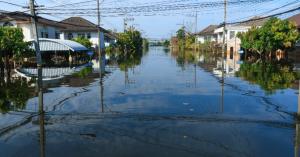When Flood Zones Become Uninsurable: Next Steps for Louisiana Property Owners
Eric Yeates, owner of ADDvantage Insurance in Houma, Louisiana, has monitored the evolving market with attention to FEMA’s mapping changes, underwriting policy shifts, and rising premium costs under Risk Rating 2.0.
“Insurers use data to determine where the tipping point lies between manageable risk and unacceptable exposure,” said Yeates. “When that balance tilts too far, entire ZIP codes may be flagged, and coverage becomes limited, non-renewed, or unavailable altogether.”
The designation of "uninsurable" is not a formal FEMA classification. Instead, it reflects a market condition where either no insurer offers coverage, or the available policies are priced beyond practical affordability. In such cases, the National Flood Insurance Program (NFIP) remains a fallback, though its rates have also increased under recent federal reforms.
Private insurers, once more active in Louisiana’s coastal areas, have pulled back in recent years due to mounting losses from repeated flooding, back-to-back hurricanes, and legal exposure following storm-related litigation. Combined with inflation in reconstruction costs and tightened reinsurer guidelines, these pressures have narrowed the options available to residents.
When private coverage disappears, policyholders typically face three choices:
Transition to NFIP Coverage
NFIP policies are available for properties in participating communities, regardless of the number of past claims. However, coverage limits are capped—$250,000 for residential structures and $100,000 for contents. In many cases, this does not reflect the full replacement value of the property, particularly for larger or elevated homes.
Retrofitting for Mitigation Credits
Elevating structures, installing flood vents, or upgrading foundation systems can reduce risk scores and, in some cases, qualify a property for coverage or discounted premiums. However, these improvements require upfront investment and do not guarantee acceptance by a private insurer.
Self-Insuring or Risk Acceptance
In the absence of available or affordable coverage, some property owners choose to self-insure. This means assuming financial responsibility for any future flood damage, which may include structural repair, mold remediation, and contents replacement. This approach carries significant risk and may not comply with mortgage lender requirements.
The mortgage implications are especially important. Most federally backed loans require flood insurance in Special Flood Hazard Areas (SFHAs). If insurance becomes unavailable, some lenders may place force-placed policies on properties—policies that often cost more and offer less coverage than those selected by homeowners.
Changing flood maps also affect insurability. FEMA’s ongoing updates to Flood Insurance Rate Maps (FIRMs) and the rollout of Risk Rating 2.0 have resulted in revised designations for many Louisiana properties. Areas once classified as moderate risk may now fall within high-risk zones due to new elevation data, rainfall modeling, and topographic changes following land loss or levee projects.
Some parishes and municipalities are responding with infrastructure investments to improve drainage and reduce flood exposure. These projects may lower flood risk scores over time, but benefits are not immediate and do not guarantee insurance eligibility. Additionally, elevation certificates, once a key tool in securing more favorable rates, have less influence under the new risk-based pricing model.
For newly constructed homes, building above BFE, installing compliant foundations, and selecting low-risk parcels can make a difference. However, land availability in less flood-prone areas is limited in many south Louisiana regions, and construction costs are often higher due to required flood mitigation.
Buyers and sellers in real estate transactions are now facing additional pressure to understand insurance availability and cost implications before finalizing deals. In some cases, properties remain unsold due to lack of insurability, or buyers are forced to renegotiate terms after discovering the cost of flood coverage during the underwriting phase.
Eric Yeates and the team at ADDvantage Insurance continue to advise clients navigating this landscape, providing education on coverage limits, risk scores, and policy options under current guidelines. Attention is also given to proposed federal legislation aimed at reforming the NFIP and incentivizing private market participation in higher-risk areas.
Morgan Thomas
Rhino Digital, LLC
+1 504-875-5036
email us here
Visit us on social media:
Facebook
Legal Disclaimer:
EIN Presswire provides this news content "as is" without warranty of any kind. We do not accept any responsibility or liability for the accuracy, content, images, videos, licenses, completeness, legality, or reliability of the information contained in this article. If you have any complaints or copyright issues related to this article, kindly contact the author above.
Flat Steel Market Gains Momentum with 6.00% CAGR, Poised to Cross USD 817.20 Billion by 2032
Recovered Carbon Black: A Circular Economy Opportunity Worth USD 4.1 Billion by 2032
Swimming Pool Treatment Chemicals Market to Reach USD 1.53 Billion by 2032, Growing at a CAGR of 2.39%
Więcej ważnych informacji
 Jedynka Newserii
Jedynka Newserii

 Jedynka Newserii
Jedynka Newserii

Polityka

Polska może się stać Doliną Krzemową Europy. Potrzeba jednak wsparcia finansowego start-upów i mocniejszej deregulacji
Polskie start-upy skoncentrowane są głównie na rozwoju nowoczesnych technologii informatycznych i cyfrowych. Wyraźny nacisk na oprogramowanie i aplikacje oraz big data i data science wskazuje na silne zainteresowanie narzędziami analitycznymi i rozwiązaniami wspierającymi transformację cyfrową w różnych branżach – wynika z raportu „Rynek start-upów w Polsce. Trendy technologiczne”, który został opracowany w 2024 roku w MRiT. Zdaniem europarlamentarzystów Polska ma szansę się stać Doliną Krzemową, jednak rozwój start-upów blokowany jest m.in. przez ograniczony dostęp do finansowania oraz niekorzystne i nadmierne regulacje.
Transport
Na półmetku wakacji ceny paliw na stacjach nie powinny się wyraźnie zmienić. Znaczące różnice między regionami i stacjami

W sierpniu ceny benzyny, oleju napędowego i autogazu powinny pozostać na poziomach z lipca – uważa ekspertka rynku z firmy Reflex. Wyższe będą zawsze na stacjach premium, tych, które oferują bogatszą ofertę dodatkową, promocje dla uczestników programu lojalnościowego, oraz w regionach, w których tradycyjnie paliwa są droższe ze względu np. na wyższą siłę nabywczą mieszkańców. Różnice mogą sięgać kilkudziesięciu groszy na litrze. Obszary, wokół których te wartości oscylują, zależą z kolei od sytuacji globalnej. Warto patrzeć na sytuację na Bliskim Wschodzie i w Ukrainie.
Polityka
A. Mularczyk (PiS): Nawiązanie poważnego dialogu z Niemcami jest konieczne nie tylko w kontekście reparacji. Powinien być podpisany traktat polsko-niemiecki

– Nie wystarczy jednorazowy gest czy inicjatywa. To musi być podjęcie dialogu, być może też przygotowanie nowej umowy bilateralnej, nowego traktatu polsko-niemieckiego, który regulowałby wszystkie obszary, które wynikały ze skutków II wojny światowej – mówi Arkadiusz Mularczyk, poseł do Parlamentu Europejskiego z PiS-u. Podkreśla, że proces ten nie będzie łatwy, bo wymaga konsekwencji i stanowczości, ale widzi szansę w prezydenturze Karola Nawrockiego, który już zadeklarował kontynuację starań w tym zakresie. Zdaniem europosła wsparciem w polsko-niemieckim dialogu może być administracja Donalda Trumpa.
Partner serwisu
Szkolenia

Akademia Newserii
Akademia Newserii to projekt, w ramach którego najlepsi polscy dziennikarze biznesowi, giełdowi oraz lifestylowi, a także szkoleniowcy z wieloletnim doświadczeniem dzielą się swoją wiedzą nt. pracy z mediami.





![Nestlé w Polsce podsumowuje wpływ na krajową gospodarkę. Firma wygenerowała 0,6 proc. polskiego PKB [DEPESZA]](https://www.newseria.pl/files/1097841585/fabryka-nesquik_1,w_85,r_png,_small.png)




.gif)

 |
| |
| |
|